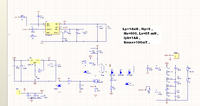tictac
Full Member level 5
I made a DC-DC flyback converter and it worked.it has a variable output voltage. But at some of the voltage range the transformer makes loud noise. The switching frequency is 50khz. it work in discontinuous mode and I use UC3842 for controller. I guess that I have oscillation at feedback loop. I check pin 1 of 3842 with scope. at normal state there is a dc voltage at pin 1 but having been a buzz heard, a 1khz sinus of waveform will emerged at the pin1 of uc3842 .
in order to improve the noise,I connect the fairly large cap across the feedback network(up too 100nf) inspite of this effort, the noise will not be vanished.
I have a low pass filter on pin 3(1K resistor and 470p cap) when I connect a larger cap (such a 1nf) to pin 3 the noise will be better .
but still,I have buzz on some of voltage range.
how Can I Vanish the buzz wholly?
Regards
in order to improve the noise,I connect the fairly large cap across the feedback network(up too 100nf) inspite of this effort, the noise will not be vanished.
I have a low pass filter on pin 3(1K resistor and 470p cap) when I connect a larger cap (such a 1nf) to pin 3 the noise will be better .
but still,I have buzz on some of voltage range.
how Can I Vanish the buzz wholly?
Regards
